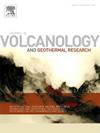The crystalline silica respiratory hazard from rhyolitic lava dome eruptions in New Zealand's Taupo Volcanic Zone: A case study from the 1315 CE Kaharoa eruption
IF 2.3
3区 地球科学
Q2 GEOSCIENCES, MULTIDISCIPLINARY
Journal of Volcanology and Geothermal Research
Pub Date : 2025-03-04
DOI:10.1016/j.jvolgeores.2025.108309
引用次数: 0
Abstract
The rhyolitic Kaharoa 1315 CE eruption was a complex, long-lived event from Tarawera volcano, New Zealand. Explosive phases were followed by around 5 years of lava dome extrusion and collapse which produced block-and-ash flows (BAF). Lava domes generate crystalline silica in the form of cristobalite, and rhyolitic magmas often contain quartz phenocrysts. Fine-grained ash containing crystalline silica can be formed through dome collapses or explosions, generating a respiratory health hazard for communities affected by ashfall. The aims of this study are to: i) determine whether the Kaharoa eruption dome-forming phase generated substantial quantities of crystalline silica and, therefore, to determine the potential for future dome-forming eruptions of Tarawera to do the same; ii) consider the potential hazard of the crystalline silica by studying the crystal habit and chemistry compared to other lava domes, globally; and iii) assess the particle size and crystalline silica content of the Kaharoa ash, to inform a respiratory hazard assessment.
Five co-BAF ash samples and one co-ignimbrite (explosive) ash sample from the Kaharoa pyroclastic deposits were analysed for health-pertinent factors: particle size distribution and crystalline silica content. Eight dome-rock samples were collected from the dome complex and associated BAF deposits and groundmass texture (especially forms of crystalline silica) and quantity of crystalline silica were assessed.
Cristobalite was present in the 4 ash samples analysed by X-ray diffraction (XRD; 1.3–3.7 wt%) as was quartz (5.7–12.5 wt%). For the 4 dome samples analysed by XRD, all samples contained quartz (4.1–10.4 wt%) and two contained significant quantities of cristobalite (24.7 and 27.3 wt%). Of the two dome samples with minimal cristobalite (visible as individual vapour-phase crystals by SEM but not quantifiable by XRD), one was from the non-devitrified dome carapace and the other was from the compacted interior but had not undergone devitrification. The two dome samples with substantial cristobalite were from dome interiors and were highly devitrified, with well-developed spherulitic textures. Using energy-dispersive X-ray spectroscopy, cristobalite in all samples contained minor aluminium, as has been seen for volcanic cristobalite from other lava domes, which may ameliorate its toxicity. By laser diffraction, the quantities of ash in the health pertinent size fractions varied, with a range of 1.3–8.1 vol% for particles of <4 μm diameter and 1.7–15.6 vol% for particles of <10 μm diameter, which is lower than measured in ash from large-scale dome collapse events at other volcanoes.
The findings suggest a potential for substantial crystalline silica to be formed in future Kaharoa-style eruptions, but that cristobalite generation is site-specific, depending on location within the dome and whether the dome remains sufficiently hot for spherulite formation and glass devitrification. Respiratory hazard will therefore vary depending on the collapse of (or explosions through) individual lobes – although all lava is expected to contain quartz phenocrysts – as well as the size and energy of those collapses, which will influence particle size and quantity of ash generated and dispersed.
新西兰陶波火山带流纹岩熔岩圆顶喷发的结晶二氧化硅呼吸危害:以公元1315年卡哈罗亚火山喷发为例
公元1315年的流纹岩Kaharoa火山喷发是新西兰塔拉韦拉火山的一次复杂而长期的喷发。爆炸阶段之后是大约5年的熔岩穹丘挤压和崩塌,产生了块灰流(BAF)。熔岩穹窿形成方英石形式的结晶二氧化硅,流纹岩岩浆常含有石英斑晶。含有结晶二氧化硅的细颗粒火山灰可通过圆顶坍塌或爆炸形成,对受火山灰影响的社区产生呼吸健康危害。本研究的目的是:i)确定卡哈罗阿火山喷发穹丘形成阶段是否产生了大量的结晶二氧化硅,从而确定未来塔拉韦拉火山喷发穹丘形成的可能性;Ii)与全球其他熔岩穹丘相比,通过研究其晶体习性和化学成分来考虑结晶二氧化硅的潜在危害;以及iii)评估卡哈罗阿灰的粒度和结晶二氧化硅含量,为呼吸道危害评估提供信息。对来自Kaharoa火山碎屑矿床的5个共baf灰样品和1个共烟灰煤(炸药)灰样品进行了与健康有关的因素分析:粒度分布和结晶二氧化硅含量。从圆顶复合体和相关的BAF矿床中收集了8个圆顶岩石样品,并对地基结构(特别是结晶二氧化硅的形式)和结晶二氧化硅的数量进行了评估。x射线衍射(XRD)分析了4个灰分样品中存在方石英;1.3-3.7 wt%),石英(5.7-12.5 wt%)。通过XRD分析的4个圆顶样品中,所有样品都含有石英(4.1-10.4 wt%),两个样品含有大量的方英石(24.7 wt%和27.3 wt%)。在含有最少方英石的两个圆顶样品中(通过扫描电镜可以看到单个气相晶体,但通过XRD无法量化),一个来自未脱氮的圆顶外壳,另一个来自压实的内部但未经历脱氮。含有大量方英石的两个圆顶样品来自圆顶内部,高度反氮化,具有发育良好的球晶结构。利用能量色散x射线光谱学,所有样品中的方石英都含有少量的铝,正如从其他熔岩圆顶中发现的火山方石英一样,这可能会改善其毒性。激光衍射结果表明,健康相关粒径颗粒的灰分含量变化较大,直径4 μm颗粒的灰分含量在1.3 ~ 8.1 vol%之间,直径10 μm颗粒的灰分含量在1.7 ~ 15.6 vol%之间,低于其他火山大规模穹丘塌陷事件中灰分的含量。这些发现表明,在未来卡哈罗瓦火山喷发中,可能会形成大量结晶二氧化硅,但方石英的生成是特定地点的,这取决于圆顶内的位置,以及圆顶是否保持足够的温度以形成球晶和玻璃脱玻化。因此,呼吸危险将根据单个裂片的塌陷(或通过喷发)而有所不同——尽管预计所有熔岩都含有石英斑晶——以及这些塌陷的大小和能量,这将影响产生和分散的火山灰的粒度和数量。
本文章由计算机程序翻译,如有差异,请以英文原文为准。
求助全文
约1分钟内获得全文
求助全文
来源期刊
CiteScore
5.90
自引率
13.80%
发文量
183
审稿时长
19.7 weeks
期刊介绍:
An international research journal with focus on volcanic and geothermal processes and their impact on the environment and society.
Submission of papers covering the following aspects of volcanology and geothermal research are encouraged:
(1) Geological aspects of volcanic systems: volcano stratigraphy, structure and tectonic influence; eruptive history; evolution of volcanic landforms; eruption style and progress; dispersal patterns of lava and ash; analysis of real-time eruption observations.
(2) Geochemical and petrological aspects of volcanic rocks: magma genesis and evolution; crystallization; volatile compositions, solubility, and degassing; volcanic petrography and textural analysis.
(3) Hydrology, geochemistry and measurement of volcanic and hydrothermal fluids: volcanic gas emissions; fumaroles and springs; crater lakes; hydrothermal mineralization.
(4) Geophysical aspects of volcanic systems: physical properties of volcanic rocks and magmas; heat flow studies; volcano seismology, geodesy and remote sensing.
(5) Computational modeling and experimental simulation of magmatic and hydrothermal processes: eruption dynamics; magma transport and storage; plume dynamics and ash dispersal; lava flow dynamics; hydrothermal fluid flow; thermodynamics of aqueous fluids and melts.
(6) Volcano hazard and risk research: hazard zonation methodology, development of forecasting tools; assessment techniques for vulnerability and impact.

 求助内容:
求助内容: 应助结果提醒方式:
应助结果提醒方式:


